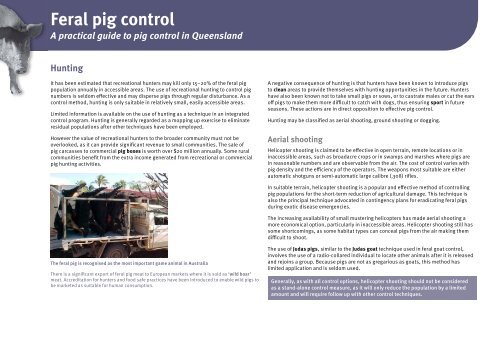Ipa Feral Pig Control Manual - Department of Primary Industries ...
Ipa Feral Pig Control Manual - Department of Primary Industries ...
Ipa Feral Pig Control Manual - Department of Primary Industries ...
You also want an ePaper? Increase the reach of your titles
YUMPU automatically turns print PDFs into web optimized ePapers that Google loves.
<strong>Feral</strong> pig control<br />
A practical guide to pig control in Queensland<br />
Hunting<br />
It has been estimated that recreational hunters may kill only 15–20% <strong>of</strong> the feral pig<br />
population annually in accessible areas. The use <strong>of</strong> recreational hunting to control pig<br />
numbers is seldom effective and may disperse pigs through regular disturbance. As a<br />
control method, hunting is only suitable in relatively small, easily accessible areas.<br />
Limited information is available on the use <strong>of</strong> hunting as a technique in an integrated<br />
control program. Hunting is generally regarded as a mopping up exercise to eliminate<br />
residual populations after other techniques have been employed.<br />
However the value <strong>of</strong> recreational hunters to the broader community must not be<br />
overlooked, as it can provide significant revenue to small communities. The sale <strong>of</strong><br />
pig carcasses to commercial pig boxes is worth over $20 million annually. Some rural<br />
communities benefit from the extra income generated from recreational or commercial<br />
pig hunting activities.<br />
A negative consequence <strong>of</strong> hunting is that hunters have been known to introduce pigs<br />
to clean areas to provide themselves with hunting opportunities in the future. Hunters<br />
have also been known not to take small pigs or sows, or to castrate males or cut the ears<br />
<strong>of</strong>f pigs to make them more difficult to catch with dogs, thus ensuring sport in future<br />
seasons. These actions are in direct opposition to effective pig control.<br />
Hunting may be classified as aerial shooting, ground shooting or dogging.<br />
Aerial shooting<br />
Helicopter shooting is claimed to be effective in open terrain, remote locations or in<br />
inaccessible areas, such as broadacre crops or in swamps and marshes where pigs are<br />
in reasonable numbers and are observable from the air. The cost <strong>of</strong> control varies with<br />
pig density and the efficiency <strong>of</strong> the operators. The weapons most suitable are either<br />
automatic shotguns or semi-automatic large calibre (.308) rifles.<br />
In suitable terrain, helicopter shooting is a popular and effective method <strong>of</strong> controlling<br />
pig populations for the short-term reduction <strong>of</strong> agricultural damage. This technique is<br />
also the principal technique advocated in contingency plans for eradicating feral pigs<br />
during exotic disease emergencies.<br />
The increasing availability <strong>of</strong> small mustering helicopters has made aerial shooting a<br />
more economical option, particularly in inaccessible areas. Helicopter shooting still has<br />
some shortcomings, as some habitat types can conceal pigs from the air making them<br />
difficult to shoot.<br />
The feral pig is recognised as the most important game animal in Australia<br />
There is a significant export <strong>of</strong> feral pig meat to European markets where it is sold as ‘wild boar’<br />
meat. Accreditation for hunters and food safe practices have been introduced to enable wild pigs to<br />
be marketed as suitable for human consumption.<br />
The use <strong>of</strong> Judas pigs, similar to the Judas goat technique used in feral goat control,<br />
involves the use <strong>of</strong> a radio-collared individual to locate other animals after it is released<br />
and rejoins a group. Because pigs are not as gregarious as goats, this method has<br />
limited application and is seldom used.<br />
Generally, as with all control options, helicopter shooting should not be considered<br />
as a stand-alone control measure, as it will only reduce the population by a limited<br />
amount and will require follow up with other control techniques.
















